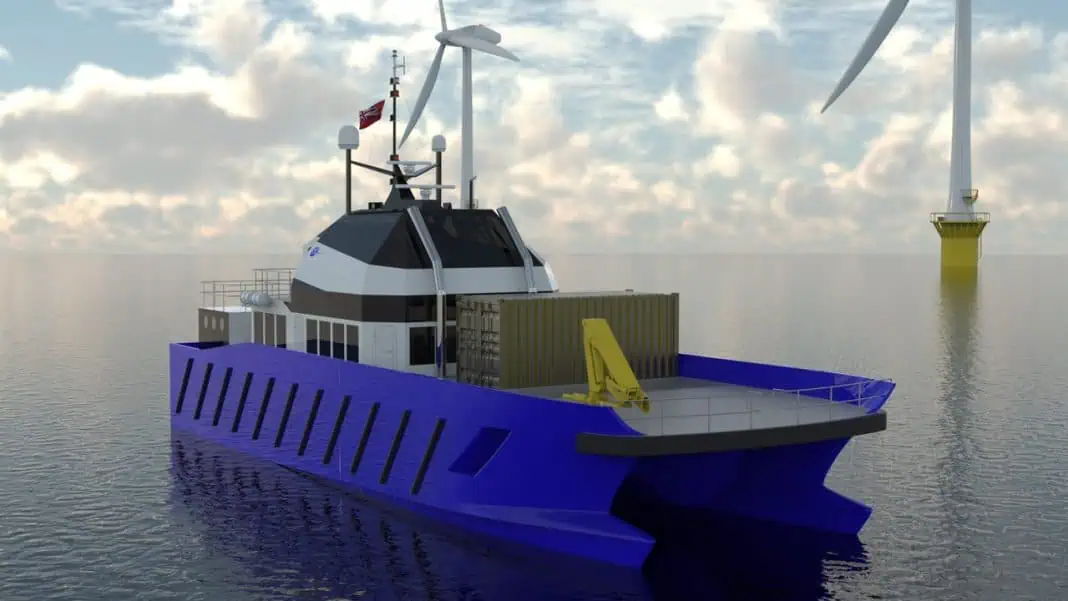As the desire to achieve zero emission vessels continues to gather pace across the marine industry, advances in technology have enabled Tidal Transit to bring forward its specifications for a Zero Emissions Capable – Real Hybrid crew transfer vessel (CTV) for use by global offshore wind farm developers and operators.
Tidal Transit’s purpose-designed CTVs have been on regular longterm charter with all key developers and operators (e.g. Orsted, Equinor, RWE, SGRE, Vestas, SSE) since 2011. The experience of working at both near-shore and more distant wind farm installations has been used in the development of the specifications for this exciting vessel concept.
Based on a 27 metre Capilano hull, the ZE Capable – Real Hybrid CTV will feature quad propulsion for redundancy. Power will be primarily delivered from modular battery packs (depending on the windfarm site) along with Gensets. The CTV can carry between 12-24 passengers, up to 4×10′ containers (or 2×20′), as well as providing above deck, 24hr marine crew accommodation.
The MJR Power & Automation offshore battery charging solution is now deliverable. Shoreside charging solutions are also becoming available across marinas worldwide with ever increasing power ratings. With these developments in infrastructure combined with the right hull form, power packs and propulsion systems, zero emissions offshore wind servicing has become a reality, without the inefficiency of producing, transporting and storing energy intensive green fuels.
Desktop analysis of real-world operating profiles for multiple sites has shown that the Hybrid can save thousands of litres of diesel daily without compromising speed or time in the field. Comparisons have been made against Tidal Transit’s existing fuel-efficient fleet along with other similar sized (26-28m) CTVs. Even without offshore charging in place, many sites in the analysis show a 50% saving in diesel usage. When considering 24hr operations for sites far from shore, where the CTV will stay in the field for up to 2 weeks, these savings become even greater. Several sites off the UK East Coast would be able to save 30,000 litres of diesel or 80 tons of CO2 each fortnight.
Tidal Transit has now started to hold vessel concept presentations and briefings within the offshore renewable energy industry and the wider marine sector.
“The feedback from our initial briefings indicates that the capabilities and specification of our ZE Ready Hybrid CTV concept exceeds the industry’s present expectations,” said Leo Hambro, Tidal Transit’s Commercial Director.
“With just a 14-16 month vessel lead time, I think the timing of our announcement is spot-on! Our market intelligence indicates that the demand for low emissions vessels (LEVs) is likely to undergo rapid expansion over the next few years as offshore wind farm developers and operators seek to minimise carbon emissions from their marine activities.”
He added: “Other low emissions vessels (LEVs) claim reductions of emissions by up to 30%, but depending upon the distance of the wind farm from shore, and the working hours operational profile, our ZE Ready-Real Hybrid CTV can be a zero emissions vessel…. a true E-CTV!
“Offshore winds’ largest carbon footprint annually is the logistics of servicing the turbines. Our solution not only reduces, and in some cases eliminates, this footprint, but also increases the yield from the turbines by being able to use the electricity from source with zero transmission, substation or grid loss. Dependent on the windfarm, the electricity may also be able to be taken pre-meter, making it as close to free as possible.”












